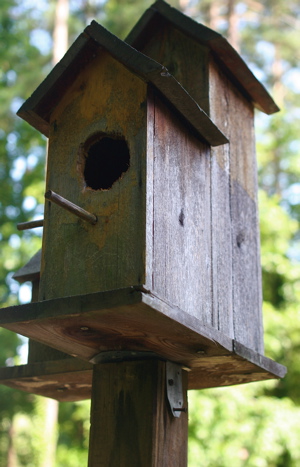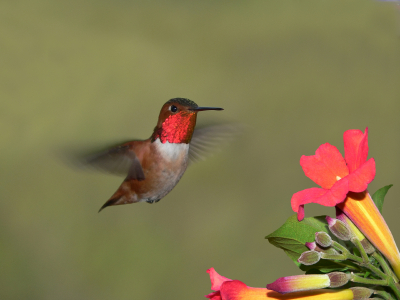- Bird Accessories, Bird Houses, Blue Bird Houses, Bluebird Houses, Decorative Bird Houses, Uncategorized, Wood Birdhouse
Got Squirrel Damage to Blue Bird Houses?
Okay…so this may not be a bluebird house, but it does represent a typical squirrel-enlarged entrance. Has this happened to any of your birdhouses?
Early fall is the perfect time to clean birdhouses in preparation for winter. Resident birds like chickadees, titmice, and wrens will use houses to roost on cold winter nights. Our bluebirds actually stuck around and over-wintered here in North Georgia last year, so blue bird houses should also receive a thorough cleaning.
An old spatula works well to remove nesting materials, and makes the perfect scraper to remove stuck-on debris. Discard nest material away from the birdhouse, as this will likely attract predators. For the safety of your health, never breath in the dust from the nest materials either. Rubber gloves are helpful too.
To salvage an enlarged entrance and restore your birdhouses, predator guards are available. Simple metal portals work well, and fit right over the entrance, denying large birds or squirrels back inside the house. Two small nails will tack these down securely and in a jiffy! Decorative predator guards are also available, and will undo the damage done to your birdhouse.
-
Don’t Touch That Window Hummingbird Feeder!
Wild bird migrations are one of those pretty amazing feats of nature. Instinct is so keen, it’s what keeps birds alive. Hummingbirds don’t begin their long journey just because the temperatures start to drop. It is the dwindling hours of daylight that signals them it’s time to go.
Many Ruby Throats are mobbing feeders right now, furiously drinking as much as they can in preparation for the long trip to South and Central America. How these tiny birds manage to fly so far is beyond me? The other pretty amazing thing is that hummingbirds practice site fidelity. Which means if they find a friendly yard with food, shelter and moving water, you can bet they’ll be back next season.
The show at our window hummingbird feeder right now is spectacular! There’s hardly a moment throughout the day where it’s not occupied. Constant feeding (and fighting) has been going on for a about two weeks. If you have nectar feeders, especially a window hummingbird feeder, be sure to keep it filled with fresh nectar for the next few weeks. Even if you think your hummers have left for the season, many that are traveling from further north of you are likely to stop by and fuel up! Be on the lookout for the occasional flying jewel, your efforts will be well rewarded.
-
Leave Hummingbird Feeders Up!
Hummingbirds are feeding like crazy right now, fattening up and getting ready for the big migration back to their wintering grounds in Central and South America. Feeders seem busier than ever with almost frantic activity at our place.
Because of the heat, sugar water is changed every two days, so filling the larger hummingbird feeders is almost pointless. Eighty pounds of sugar were used to feed our local hummer population this season…and that’s a lot of nectar!
If you don’t make your own nectar-give it a try before the season’s over. Hummingbirds really seem to prefer the simple sugar water solution, and it saves money too.
The recipe: 1 part sugar to 4 parts water…that’s it! No red dye necessary. Use plain white table sugar and nothing else as it will harm hummers. You don’t even need to boil the water as microorganisms and bacteria are actually spread through the bird’s beaks on the feeder ports. We boil 1 cup of water, simply to help dissolve the sugar more effectively. And contrary to popular belief, hummingbirds will not “stay” if you leave feeders up – Mother Nature tells them when it’s time to go!




